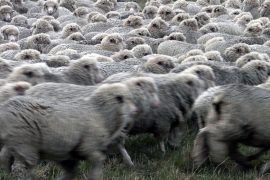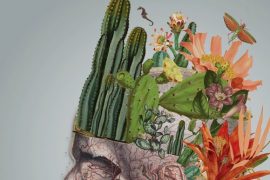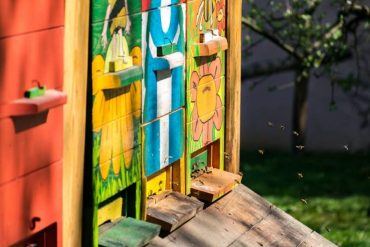Several years ago, I came upon Sandra Critelli’s stunning photograph of migrating cownose stingrays appearing as an intricate pattern of yellow, tan, and green in the blue-black water off the coast of the Yucatán Peninsula. Imposed upon that image were the words of Henry Miller, cited here a bit more fully, “The world has not to be put in order: the world is order incarnate. It is for us to put ourselves in unison with this order, to know what is the world order in contradistinction to the wishful-thinking orders which we seek to impose […].”¹ Those words and that image came back to mind while making my way through Gayle Boss’s Wild Hope for reasons that I will explain.
Boss writes that this rather unusual book for Lenten reflection emerged from the year she stumbled upon explaining the season to her young sons through Noah’s Ark—long seen as a symbol of the Christian Church and its baptismal passage. As they put a different model animal aboard their improvised basket-ark each night, they shared attentive words of appreciation about why they were glad that particular being was there. Along the way, with articles and photographs of species-extinction increasing, it became powerfully evident to her that “[t]his beautiful blue-green globe is the one ark we all ride” and that if anything, Lent is about being roused from “our self-absorption” so that we might enter more fully into the suffering groaning and hopeful longing of Creation about which St. Paul wrote in his Epistle to the Romans.
This book invites the reader to enter the beautiful intricacy of fellow creatures’ form and existence while also addressing encompassing and encroaching fragility—most often caused as it is by selfish, unthinking human behavior, but also countered by informed and impassioned human actions on behalf of bold resurgence. Beginning with the Sumatran Orangutan on Ash Wednesday and continuing with meditations on four animals a week through Easter Sunday, lovingly detailed portraits are presented for deep and attentive contemplation. Accompanied by David Klein’s stunning black and white engravings of each creature in native habitat, the lives and plights of the threatened species are laid out progressively from the hungry to the sick and the homeless, to the poisoned and the hunted, all through to the desecrated for Holy Week. Here are recognitions of wonder, laments of loss, and longings for restoration seeking resonance for the Lenten pilgrimage. Boss writes in order that eyes may be opened more widely, and then, “alive to the exquisite web holding all creatures, we also see the holes slashed through it. By us. We’re enraptured by the animals’ beauty, and we’re horrified by the suffering we inflict on that beauty.”
According to the Gospel of Mark, immediately following Jesus’ baptism, the Spirit plunged him into the wilderness for the forty days that St. Mark says had him with “the wild animals” even as he was tempted by Satan and ministered to by angels (Mark 1:13). While often understood as meaning that Jesus was tormented and ravaged by “beasts,” the ambiguity allows seeing it through the lens of Isaiah 11:6-9 with Jesus’ inauguration of the peaceable kingdom between predator and prey—banishing hurt and destruction, filling the earth and its seas with full knowledge of the Lord. The devil, as St. Matthew relates (Matthew 4:1-10), would have none of it and attacked Jesus at the place of primal hunger before attempting to lure him into the reckless use of power, followed by the greedy appeal of possessiveness. Jesus resisted and instead asserted his identity as the divinely human redeemer and rightful steward of Creation. This, I suggest, is a helpful template for working through each week of Wild Hope, from hunger to desecration, while wondering where Christ is in all of this—in every way that can be meant.
How can people, made to image God forth in the world and tend it with care, ravage orangutans’ forest home in order to have a cheap palm-oil source for cookies, ice cream, and shampoo—or kill and mutilate rhinoceroses and elephants solely for the mystique of possessing their horns and tusks—or poison waterways with byproducts of mining and manufacture so that water cleaning mussels and habitat-sustaining river otters die in droves? By being so deluded through the devilish temptations of self-absorption and self-idolatry that reverent wonder and the outward-reaching vocation of caretaking are lost. While laying bare the grim realities of these creatures’ threatened survival is certainly part of this book’s endeavor, as the name itself demonstrates, it’s largely about the bold signs of hope to be found in the perseverance and preservation of the wild and untamed. Reminding the reader that Lent is a season of necessary change which ultimately evinces Easter newness, Boss asserts what must be taken to heart and mind and life: “The promise of Lent is that something will be born of the ruin, something so astoundingly better than the present moment that we cannot imagine it. Lent is seeded with resurrection.”
While I assume I won’t be the only one to approach Wild Hope’s pages unaware of olms, reading of these salamanders that dwell solely underwater in subterranean caves, can survive for up to a decade without food, and live as long as a hundred years cannot help but amaze; yet learning of their imperiled existence resulting from insidiously permeable toxic waste, as well as the researcher-driven efforts of hatching and restoration cannot but push one to the ragged edge on the tiptoe of expectation. Eagerly working to combat the rapid shrinkage of Madagascar’s ring-tailed lemur population from 750,000 to 2,500 in the course of their short lives to that point, students work to increase awareness of mutuality in both human and forest flourishing along the way. And in the Congo, too-long ravaged by displacement and the horrors of civil war, bonobos and people recover their ancestral homes and generational traditions while growing in peaceful interdependence and protection. Lest anyone think personal involvement remote and out-of-reach, or that lament cannot be met by labors of hope-filled acts of love, the Afterword includes organization websites for each species featured so that participation for the good of each and every can be undertaken within this wide Creation.
Only weeks into Lent this year, the coronavirus reached outbreak proportions and brought sudden change to everyone’s lives in one way or another. Reading of alarmingly diminishing bat colonies and of the culinary demands that make the Chinese pangolin “the world’s most trafficked animal,” only to hear about the likely origin of the coronavirus in bats or pangolins and discover that scientists since the last decade already have been warning of animal infections producing human pandemics brought otherwise distant species and habitat destruction extremely close to home. A pointed lesson exists in researchers’ discovery that the European cousins of Indiana bats developed immunity, over time, to the white-nose syndrome decimating them, prompting Boss to observe astutely that “Though it seemed to destroy them, the bats have found deep within the group-body a force that answers death with resurrection.”
Yes, we are a part of an astonishing and suffering Creation. What the present moment calls for is the relinquishing of naïve wishful thinking within an unchanged framework of selfishness. Learning to gaze anew at the intricate and fragile beauty of this Creation which Christ came to redeem and restore is the wilderness lesson of Lent; equipping us to live eucharistically hope-charged lives within the ecology of Easter. How can one not read about and behold, on Maundy Thursday, the image of the Atlantic bluefin tuna, overfished and sliced into fillets, and not think of Jesus giving himself as the sacrificial Passover Lamb—or for that matter as the Risen Christ hungering and eating broiled fish that day of his resurrection and later on putting his disciples’ caught fish on the fire for their own breakfast? There is much to ponder and discover in this work for those willing to have eyes, mind, and heart opened more fully to the wild and daring realization that is Boss’s final sentence: “Love takes flesh and makes all things new.”
¹ “Creation,” The Henry Miller Reader.





